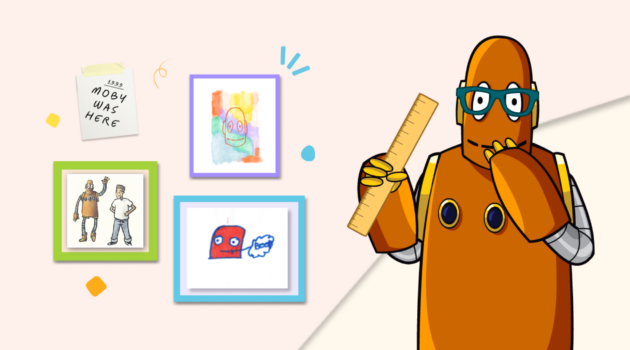Home Learning
Why Downtime Is the Best Time to Spark Creativity and STEAM Learning

Does a long weekend, school holiday break, or approaching summer vacation set you on a quest to plan a full lineup of activities and outings for your family? While some structure is great, experts encourage us to embrace the white space in our days to make room for curiosity, exploration, discovery, and playful learning. According to the late Sir Ken Robinson, an international expert on education and creativity, “Imagination is the source of all human achievement,” and kids thrive when given the time and space for inventive thinking. Robinson also said, “You can be creative in anything—in math, science, engineering, philosophy—as much as you can in music or in painting or in dance.”
When my daughters were young, I was a pro at carving out time for creative play and literacy learning. They would spend hours devouring books, creating stories with invented characters, and writing in their journals. Because I wasn’t as comfortable with science and math, however, I didn’t know how to naturally build on those skills and interests. For parents or caregivers looking for some guidance, here are five creative, STEAM-focused activity ideas inspired by Aimee Bloom, an instructional technology coordinator in Buffalo, New York. All you need is some downtime to rev up the learning!
1. Set up a challenge and step away
Brainstorm an everyday problem for your kids to solve. Maybe it’s a chore that they want to make easier, or something around your home that needs fixing or improving. Lay out whatever props and supplies you have on hand, such as paper towel rolls, discarded twine, empty shoe boxes, extra buttons, cotton balls, popsicle sticks, building blocks, fabric from clothes headed to the giveaway center, scissors, tape, and more. Then invite your kids to imagine and design their own solutions. Since this challenge has no right or wrong answers, you can resist the urge to help your kids perfect their ideas. “It’s the process that is important here,” says Bloom, who also emphasizes the value of letting kids develop something that fails, tweak their idea, and try again. “Set up the constraints, and see what they come up with,” she adds. “Let them work through the problem on their own. You’ll be amazed.” Even more important than the results is the engineering mindset that kids develop by setting a goal, testing a prototype, and making iterative changes for design improvements. Invite your child to learn more about breaking down and solving problems by watching the BrainPOP movie, Computational Thinking.
2. Let them grow—literally
Gardening is a terrific way to inspire exploration of the scientific method—all it takes is a seed packet and a small container of dirt to get started. Help your kids count the seeds and measure the distance between plants. Or, suggest an experiment comparing the progress of one plant grown with chemical fertilizers and one grown organically. Why does one seed sprout before the other? Using what they learned, prompt them to think how they might keep the leaves from turning brown next time. Take a walk around your neighborhood, or visit a local park, prompting your kids to observe these natural ecosystems. Then, have them recreate the elements in their own container or corner of your backyard. Help them collect rocks, moss, and seedlings for their garden, and encourage them to sketch their designs, keeping notes on the results as they go. Bloom recommends letting your kids dig in and enjoy. It’s okay to get dirty with this activity! You can also download a plant ID app to take on your outings to discover details about newfound natural wonders.
While some structure is great, experts encourage us to embrace the white space in our days to make room for curiosity, exploration, discovery, and playful learning.
3. Let off STEAM in the kitchen
All kinds of learning happens naturally in the kitchen. According to Bloom, “Cooking is an easy way to tie math into real-life examples.” If your kids are learning fractions, for example, challenge them to double a favorite recipe, or cut it in half. While shopping for ingredients, have them count the eggs, read amounts on the ingredient labels, convert cups to ounces, and compare prices of different brands or amounts. “They will understand the math better when it is used in a practical application,” says Bloom, “even if they feel lost when a similar problem is presented on paper in class.” Bloom has her own kids make their lunches every day. Cutting a sandwich in halves or quarters can suddenly make the abstract idea of fractions tangible. You can also have kids estimate what size container to use for different portions of leftovers during mealtime cleanup. And don’t forget to put the “steam” in STEAM! Your tea kettle offers another perfect research opportunity. There’s science behind the whistle effect as steam escapes through the tiny hole.
4. Encourage journaling
If you think journaling is just a writing exercise, think again. Science, technology, engineering, art, and math all benefit from the discipline of documenting plans and the steps involved in executing them. It’s important for young inventors to have a place to capture all of the ideas whirling around in their imaginations. Ask questions to prompt reflection: What are the blueprints of your design, experiment, recipe, or equation? What worked and what didn’t? How did you feel about the results? Keeping a journal helps children understand the process of creative thinking and discovery, which empowers them to evolve their approach the next time around. And what if your kids become frustrated by their failures? Remind them of Sir Ken Robinson’s wise words: “If you’re not prepared to be wrong, you’ll never come up with anything original.”
5. Get your game on
Board games, card games, and dice games are fun ways to fold math learning into playtime. An even better way to spark your child’s STEAM engine is letting them create original games, and develop their own point systems and rules. “There are no mistakes or wrong answers when kids are creating their own games,” Bloom reiterates. Constructing original boards, cards, and tokens is both creative and fun! “Sloppy is okay. Allow that,” says Bloom. If they invite you to join, ask them to explain the rules, and just play along. Don’t be surprised if the rules change halfway through. That’s creativity at work! For your next family night, empower them to reinvent their game design for maximum fun.
These five ideas are just the beginning! When guiding your kids, be sure to meet them where they are developmentally, and look for open-ended opportunities to leverage their interests.
Karen Kane is an editorial, marketing, and communications professional focused on creating meaningful print, digital, and real-world experiences for kids, parents, caregivers, and educators. She always wanted to be an engineer, but didn’t have the math and science chops to follow in her father’s footsteps. She credits regular cribbage and card games with improving her and her daughters’ basic math skills.






